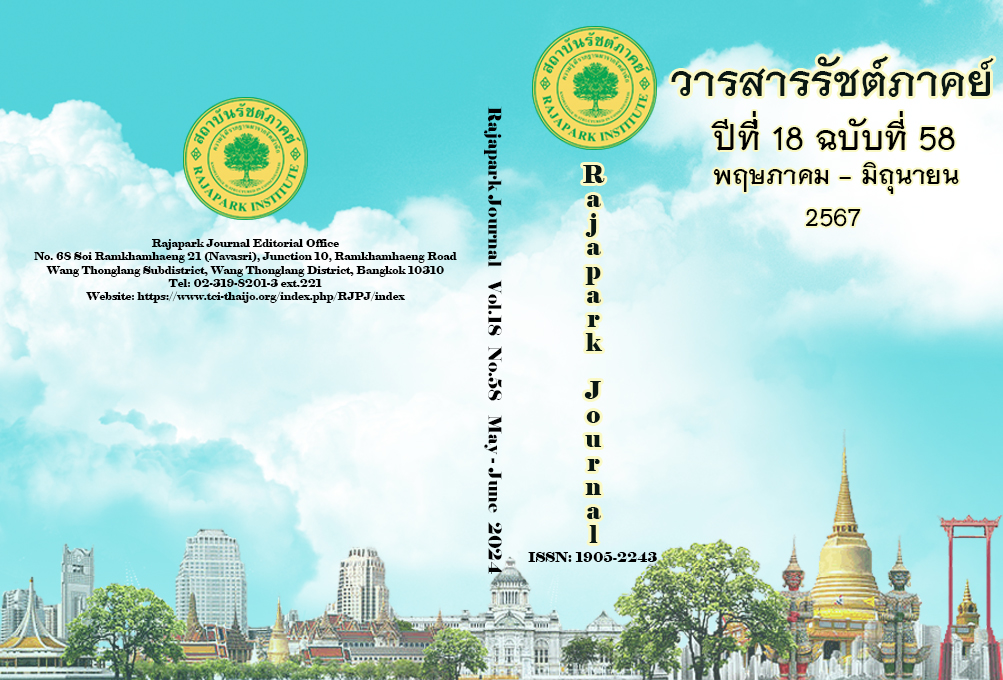The Potential and Development of Tourism Based on Biodiversity and Local Wisdom Wangnamkeaw Sub-District, Wang Nam Khiao District, Nakhon Ratchasima Province
Main Article Content
Abstract
The objectives of this research were 1) to study the potential for tourism development and 2) to study the needs of tourists towards tourism development based on biodiversity and local wisdom in Wangnamkeaw Sub-district, Wang Nam Khiao District, Nakhon Ratchasima Province. The research used mixed methods; qualitative data was collected using in-depth interviews with a focus group of 48 community leaders from the government, private sector, and public sector. Quantitative data was collected using a questionnaire on 300 tourists who visited Wangnamkeaw Sub-district. Data were analyzed using descriptive statistics to find the percentage, mean, standard deviation, and content analysis. The results showed that Wangnamkeaw Sub-district, Wang Nam Khiao District, Nakhon Ratchasima Province, has the potential for tourism development based on biodiversity and local wisdom, and there are natural resources, cultures, a variety of lifestyles, and the completeness of local wisdom. The needs of tourists toward the development of tourism based on biodiversity and local wisdom of Wangnamkeaw Sub-district, Wang Nam Khiao District, Nakhon Ratchasima Province, showed that the needs of tourists meet the highest overall demand for all seven tourism factors. When considered separately, the most important needs of tourists were the factor of tourist attractions, the factor of facilities, the factor of tourist programs, the factor of tourism activities, the factor of access to tourist attractions, the factor of ancillary services, and the factor management in the area, respectively.
Article Details

This work is licensed under a Creative Commons Attribution-NonCommercial-NoDerivatives 4.0 International License.
Views and opinions appearing in the Journal it is the responsibility of the author of the article, and does not constitute the view and responsibility of the editorial team.
References
Best, J. (1977). Research in education. Prentice Hall.
Buhalis, D. (2000). Marketing the competitive destination in the future. Tourism Management, 21(1), 97-116.
Collier, A., & Harraway, S. (1997). Principles of Tourism. Longman.
Cronbach, L. J. (1990). Essentials of psychological testing (5th ed.). Harper Collins.
Dachum, P., & Ratanasuwongchai, N. (2019). Bio tourism standard manual. Development office Bio-based economy (Public Organization), Faculty of Humanities, Kasetsart University.
Goeldner, C., & Ritchie, J. R. B. (2006). Tourism: principles, practices, philosophies (10th ed.). Wiley.
Heritage Council of Western Australia. (2022). Strategic and policy documents for the heritage council of Western Australia. Annual report 2022-2023. https://www.wa.gov.au/governent/document-collections/heritage-council-of-western-australia-publications
Jones, P. (2022). Tourism and biodiversity: A paradoxical relationship. Athens Journal of Tourism, 9(3), 151-162. DOI:10.30958/ajt.9-3-2
Juntapoon, P., Sahatrongjit, T., & Thaeye, K. (2023). The potential of tourism based on the use of biodiversity resources for creative tourism: Ban Mae Phung Luang, Mae Phung Subdistrict, Wang Chin District, Phrae Province. Journal of Management Science Research, Surindra Rajabhat University, 7(1), 113-127.
Koment, J., & Panyadee. C. (2020). The development of criteria and regulations for ecotourism management based on biodiversity and bioconservation of the community based social enterprise. Journal of Thai Hospitality and Tourism, 15(2), 92-104.
Krungthai COMPASS. (2023). Economic outlook, Economic direction in 2023. https://krungthai.com/Download/economyresources/EconomyResourcesDownload478Economic_Outlook_2023.pdf
Likert, R. (1967). The method of constructing and attitude scale. Attitude theory and measurement. Fishbeic, Martin, Ed. Wiley & Son.
Manopawit, P. (2021). Tourism based on biodiversity and revitalizing the economy and protecting the environment after COVID-19. https://bkktribune.com
Ministry of Tourism and Sports. (2017). National tourism development plan 2017-2021. Department of Tourism, Ministry of Tourism and Sports.
Ministry of Tourism and Sports. (2020). Tourism policy. http://www.mots.go.th/ewt_news.php?nid=5953.
National Economic and Social Development Council Officer. (2022). National economic and social development plan no. 13 (2023-2027). Royal Gazette. http://www.ratchakitcha.soc.go.th/DATA/PDF/2565/E/258/T_0001.PDF
Ninerola, A., Sánchez, R. M, & Hernández, L. A. (2019). Tourism research on sustainability: A bibliometric analysis. Sustainability, 11(5), 1377. DOI:10.3390/su11051377
Pelasol. J. (2012). Igcabugao: A potential tourist destination in the Southern Part of Iloilo. Philippines International. JPAIR Multidisciplinary Research is Being Certified for QMS ISO 9001, 8, 90-97. (Mimeographed).
Pike, S. D. (2008). Destination Marketing: An integrated marketing communication approach. Butterworth-Heinmann, Burlington, MA.
Rovinelli, R. J., & Hambleton, R. K. (1977). On the use of content specialists in the assessment of criterion-referenced test item validity. Tijdschrift Voor Onderwijs Research, 2(2), 49-60.
Thai Social Enterprise Office (TSEO). (2010). Social enterprise master plan 2010-2014. TSEO.
United Nations Environment Program. (2007). Vertical designation of enforcement responsibilities for enforcing pollution-control laws in the United States. http://www.unep.org/dec/onlinemanual//Enforcement/InstitutionalFrameworks/DesignationofResponsibilities/Resource/tabid/807/Default.aspx
Visadsoontornsaku, P., Na Thalang, C., Jittithavorn, C., & Tungbenchasirikul. S. (2020). Potentiality development approach for community-based tourism in Nakhon Ratchasima province. The Journal of Development Administration Research, 10(3), 22-33.
Wangnamkeaw Sub-district Administrative Organization. (2023). Demographic information of Wangnamkeaw Sub-district Administrative Organization. https://www.wangnamkeaw.go.th/showall.php?cg=2&ct=13
Wangnamkeaw Sub-district Administrative Organization. (2023). General conditions and basic information of Wangnamkeaw Sub-district Administrative Organization. https://www.wangnamkeaw.go.th/info.php?cg=2&ct=7
World Tourism Organization. (2016). Tourism, a factor of sustainable development. http://ethics.unwto.org/en/content/global-code-ethics-tourism-article-3
Yamane, T. (1973). Statistics: An Introductory Analysis (2nd ed.). Harper and Row.
Zhen, L., Lan, J., Chien, F., Sadiq, M., & Nawaz, M. A. (2022). Role of tourism development in environmental degradation: A step towards emission reduction. Journal of Environmental Management, 21(25), 374-478. DOI:10.1016/j.jenvman.2021.114078


